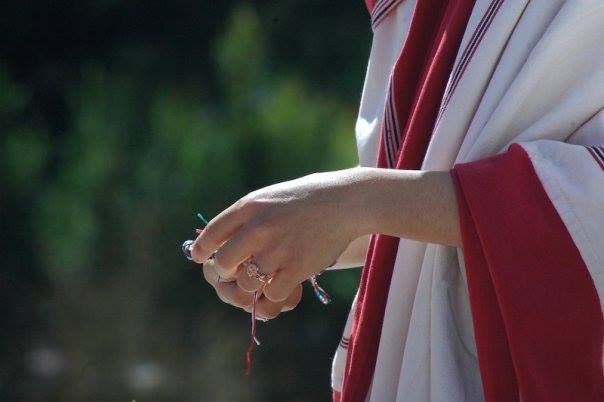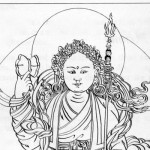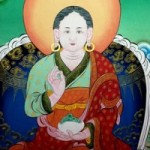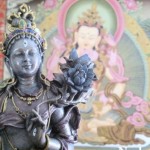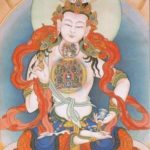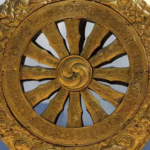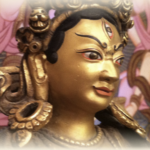Zurmo Gendun bum – A Post on Buddhist Women in Tibetan History
There was a fourteenth century (1) female master of the Nyingma lineage who came from the Zur family. Her name was Zurmo Gendun bum. (Tib. zur mo dge ’dun ’bum). Nyingma yogini, member of the powerful Zur family, endowed with natural dignity, female exemplar and vajra master, Zurmo Gendun bum was said to be a multifaceted practitioner. She mastered the intellectual, contemplative and ritual practices.
Sources about women in Tibetan Buddhism and women in Buddhism in general are sparse. So her brief biography provides an interesting glimpse at a woman in Buddhist history. I am in the midst of researching her for an article I am writing, but the details that have emerged already have surprising elements. (2)
Zurmo Gendun bum was a master of the oral-lineage transmissions. Buddhist teachings of Tibet’s Nyingma lineage have been passed through various over-lapping systems. These include family lineages, tulku traditions, ordination lineage and institutional traditions associated with particular monasteries. But the two major overarching categories for how lineage is passage are known as the ‘short lineage’ of the treasure revelations and the ‘long lineage.’ (Aka – gterma and bka’ ma). This yogini held and transmitted the long lineage.
The long lineage refers to the oral transmission of Buddhist teachings and practices that were given from teacher to student since the time of the Buddha. Within the early era of the long lineage in Tibet, four families played a major role and one of these was the Zur clan. (3) Among the Zur lineage lists is a female Buddhist teacher and yogini known as Zurmo Gendun bum.
Zurmo Gendun bum was a lineage holder of the “Sutra which Gathers All Intentions,” which is an important practice text of the Buddhist inner tantras. A famed Tibetan Yogi (ngakpa) Nupchen Sangye Yeshe, is remembered for having brought the Anu Yoga teachings to Tibet and this text is a principle Anu Yoga text. Anu Yoga are a class of Nyingma inner tantra concerned with the subtle body meditation practice. One of the principle texts of these practices is known as “The Sutra which Gathers All Intentions,” (Tib. mdo dgongs pa ‘dus pa) – which the lady Zurmo Gendun bum was a teacher of.
Although the empowerment for these teachings was given to both Zurmo Gendun bum and her brother (4) according to Dudjom Rinpoche’s history, and she became the holder of that lineage.
In a rare portrayal of an early female Buddhist lineage holder, her brief biography describes her as a ‘natural yogini.’
“In reality, she was a natural yogini, who from her youth onwards was dignified, even in appearance and free from the defects of samsara. Training herself in the three aspects of creation and perfection, she attained their limits, realized the abiding nature of reality, and mastered many approaches to contemplation. Thus, she became a great learned and accomplished woman.” (5)
Another notable aspect of this description was that she was endowed with dignity. To say that she was free from the ‘defects of samsara’ is to refer to being free of the mental angst and neurosis which comes from living without awareness of one’s true nature.
The biography describes her practice – it is the practice of creation and perfection stage – the primary Vajrayana practices. These practices center around visualization and identity transformation through meditating on and then merging with a buddha, or another wisdom being. It is the ultimate psychological transformation, the practitioner transitions from an ordinary view of oneself as separate and mundane to an expanded vision of oneself as radiant, wakeful, deeply connected to the lineage and with a life purpose to help others. Not only was this eleventh century woman trained in such practices, she is also said to have mastered them and many other methods.
Moreover, another point of interest is that she was portrayed as a Vajra master (Tib. rdo rje slob dpon) who was authorized to give such transmissions to students. This is a high ranking Buddhist teacher. Historically, these roles have usually been occupied by male teachers.
In another noteworthy element of her biography, we are told that she was a teacher of male students. Therefore she played a role in the continued transmission of this text, not just to other women but to the successors of the lineage and to male students. It was she who gave the empowerment of this text to Zurton Sakya Shenyen and due to this the lineage continued. (6)
A fascinating aspect of this biography is that she is portrayed not only as a contemplative master, but also as someone who is ‘learned,’ suggesting a well rounded and accomplished practitioner of meditation, ritual and intellectual learning.
Where are other sources for Zurmo Gendun bum’s life?
In the eighteenth century she appears in Jigme Lingpa’s records. Sam van Schaik’s research includes her listed in the translation of the lineage record (thob yigs) of Jigme Lingpa in the text entitled The Sun and Moon Earrings (Tib. Nyi zla’i rna cha). It has a list of names of lineage holders. It begins with the famous Ngakpa Nubchen Sangye Yeshe and goes on to the famous eighteenth century yogi, Jigme Lingpa. But somewhere in the middle is a female Vajra master and lineage holder, Zurmo Gendun bum.
“…from gNubs-chen, So Ye-shes dBang-phyug, by him to Rab-thung, Ra-thung and Kong-btsun, and heard from those three by Nyang Sher-mchog, from him to Nyang Ye-shes ‘Byung-gnas, Zur-po-che Shākya ‘Byung-gnas, Zur-chung Shes-rab Grags, the four heart-sons and eight descendents, sGro-phug-pa Shākya Seng-ge, rTsags-ston Shākya rDo-rje, rTsags-ston Shākya ‘Byung-gnas, Glan rDo-rje ‘Od, Glan bSod-nams rGyal-mtshan, Chos-kyi Seng-ge, Glan Buddhashrī, Glan bSod-rnams mGon-po, sGrol-ma-ba bSam-‘grub rDo-rje, Zur-mo dGe-bdun ‘Bum, Zur Shākyamitra, Dharmalakṣa, dKon-mchog bZang-po, rDo-rje bZang-po, Badzra Bidzrayamitashrī, Karmā Guru, Kun-bzang dPal-‘byor, Phrin-las Lhun-grub, Chos-rgyal bsTan-‘dzin, gTer-gling-pa, mKhan-chen Lotsā, Khri-rin-rnam, bsTan-‘dzin rDo-rje, Khri-‘gyur-rnam, sGom-ri Orgyan Klong-yangs…” and then ‘Jigs-med Gling-pa.”
Here is a link to that article of van Schaik’s which argues for the benefit of these lineage records – thob yigs – as historical records. Case in point, our subject Zurmo Gendun bum appears there. Thus it reveals evidence of continuous memory of her as a significant link in the chain of lineage transmission. Such a record helps to fill in gaps in the history of Buddhist women by recording a female teacher’s existence within a wider literary context where many women were left unnamed.
This important Buddhist woman also appears in a seventeenth century record. She is described in the collected works of the fifth Dalai Lama Ngawang Lobsang Gyatso (Tib. ngag dbang blo bzang rgya mtsho), in the liberation story of all the great Zur, Khyenpa Cho ying Rangdrol. (7)
གཅུང་ལྷ་ཆོས་མི་ཆོས་ལ་མཁྱེན་པ་ཆེ་བ་དེ་ཕོ་བྲང་ཏའི་ཧུར་དགུང་ལོ་ཉེར་ལྔ་པ་ལ་གཤེགས་ལྕམ་སྲིང་མ་མི་ཆོས་མཛད་པའི་མཚན་ཟུར་མོ་དགེ་འདུན་འབུམ་ཞེས་རྡོ་རྗེ་མཁའ་འགྲོའི་སྤྲུལ་པར་བྱེད།
The biography states – “As for the zur sister, her worldly name was Zurmo Gendun bum (Tib. Zurmo dGe ‘dun ‘Bum), she was an emanation of Vajra Dakini (rdo rje mkh’ ‘gro).”
In other words, this record states that she was no ordinary person, but was regarded as embodying a high level of realization. For Buddhist women to be regarded as emanations of dakinis, buddhas, previous masters or other divine figures is a manner of acknowledging and endowing these women with authority. It is a way of intimating that she was accomplished.
This early female Buddhist master also appears in a fourteenth century record. She is mentioned in the Blue Annals (8). This text is major source for early Tibetan Buddhist history. It was written by a fourteenth century historian Gö Lotsawa (Tib. gos lo tsā ba gzhon nu dpal). There are no biographical details there, however her name appears in a record of who held and passed on the lineage.
The record of Zurmo Gendun Bum raises the question of women’s roles as religious leaders in the fourteenth century and in the Zur lineage. How many other women ascended to the rank of Vajra Master during this time? What other biographical sources might exist filling in more details about her life?
Footnotes
(1) Here I follow the TBRC library dates for her life which identifies her as a 14th century figure.
(2)There is a brief english version of her life in the passage on the Zur lineage in the Nyingma Fundamentals. See – Rinpoche, Dudjom. The Nyingma School of Tibetan Buddhism: Its Fundamentals and History (Somerville, MA, Wisdom Publications 1991). Kindle Edition. 15507-15508
(3) See a pithy discussion of this by Dilgo Khyentse Rinpoche:
Rinpoche, Dilgo Khyentse. Zurchungpa’s Testament. (Snow Lion Publications, 2007).
(4) Dudjom Rinpoche
(5) Dudjom Rinpoche
(6) There seems to be some variations in the sources listed about who followed her in the lineage here, so further research will be necessary to sort out the succession.
(7) ngag dbang blo bzang rgya mtsho. gsung ‘bum (krung go’i bod rig pa dpe skrun khang, 2009)
For more of Pema Khandro’s articles on Buddhist Women, check out these links:
Buddhist Women – Tibet’s First Female Tulku (reincarnate lama)
Also
https://pemakhandro.org/buddhist-women-one-nuns-hardship-beauty/

